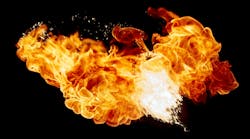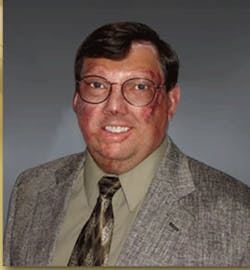A Kansas breeze rattles Brad Livingston. A simple billow unsettles the retired laborer from Colorado Interstate Gas, when recalling Sept. 20, 1991.
“I’m fortunate I’ve never had a single nightmare being inside that fireball,” he says of that late-summer Friday. “The one thing that gets me is a sudden gust of wind. I’ll never forget the feeling, and the force of that explosion hitting me.”
It was break time, 10 a.m., on Sept. 10, and Livingston had been working on the pipeline and as a dispatcher for 10 years. That day he was filling in that day as a welder’s helper. It was grunt work, but he was happy to be in the field.
“I was third in line to fill in…” he remembers. “I felt like the new kid again. Any other day I wouldn’t have been there.”
Shortcuts Prove Deadly
Livingston and his welding partner Tracy, his former Little League coach, had been on site in rural Oklahoma all morning, when the company pumper said a natural gas well had two drip gas tanks with pinhole leaks. Tracy had 30 years’ experience welding and agreed to the job. He moved toward the side-by-side tanks, filled with crude oil, water and drip gas – a naturally occurring form of gasoline.
“They are sitting bombs,” Livingston now says. “I had a gut feeling, like we were rushing into this.”
Livingston used a gas monitor to ensure the atmosphere was safe to weld and asked Tracy, “What will keep a spark from getting inside one of those drip tanks?”
Liquid had pooled at the bottom of the tanks, and the company pumper told Tracy the liquid level was seven feet high in each tank. Tracy was welding just 18 inches off the ground. If he accidently burned through the tank while welding, the liquid would snuff the fire out immediately.
Livingston didn’t second-guess his friend and former baseball coach. The duo didn’t take the three extra minutes to walk the catwalk, flip the hatch and measure the liquid level in each tank.
“We assumed the information was right,” Livingston remembers. “We added a job to a busy day. It was nothing but a shortcut.”
Unfortunately, the company pumper was wrong about fluid levels.
Livingston rolled the leads out for Tracy, who lay on the ground to weld the pinhole leak in the first tank. Minutes later, he had burnt through the second tank. A spark ignited the gas inside.
The Thunder Rolls
Livingston heard the rattle.
“I can’t describe it,” he says. “We have thunder storms here; the thunder starts in the distance and makes a gradual roaring sound. Then all of a sudden there is a boom that takes 3-7 seconds to get there. That’s kind of what happened, but it took half a second. I had enough time to holler, ‘It’s gonna’ blow!’”
The first explosion turned Livingston into a human fireball. He flew more than 10 feet into the air and landed on top of the second drip tank.
“When I saw the catwalk I knew where I was,” he says. “I was angry. I thought I was going to die, that I wasn’t going to raise my three daughters.”
Twelve seconds later, the second tank exploded underneath Livingston, and he was hurled into the fireball once more. He landed on the ground, engulfed in flames. He mustered the strength to roll away from the cloud of fire, his broken leg flailing with each roll.
Somewhere within the flames and raindrops of crude oil, Tracy lost his life.
The explosions were heard miles away. Nearby ranchers witnessed the scene, and followed the sound of Livingston’s screams. They found him smoldering, but not in flames, and dragged him through the fields away from the accident. Livingston believed every breath he took was his last. The ambulance arrived 20 minutes later.
The last thing he remembers is saying a prayer and ending with “amen.”
Cotton Barrier
Livingston wore a new pair of jeans that day – a 40 percent polyester and 60 percent cotton blend that would melt through his nerve endings, through his entire layer of fat cells, and into his leg muscles.
“The ranchers didn’t think my jeans had been burnt because they looked okay,” he says. “I was covered in oil. They didn’t realize the polyester would continue to melt even after being in the burn unit for a couple weeks.”
OSHA didn’t have the same personal protective equipment (PPE) requirements then as it has today. Now, employees exposed to the hazards created by welding, cutting or brazing must be protected by PPE in accordance with regulation 29 CFR 1910.132.
An estimated 500,000 workers in oil and gas well drilling operations must wear flame-resistant clothing, as the risk from fatal injuries in this field is more than four deaths per 1,000 workers over a working lifetime. In 2013, 112 workers were killed in the oil and gas industry, according to the Bureau of Labor Statistics.
In December, OSHA announced that rapid growth in the industries had been coupled with an increase in worker fatalities, and signed an alliance with the National Service, Transmission, Exploration & Production Safety Network to help protect workers.
Livingston also wore two layers of cotton shirts that day – one long-sleeved, one short-sleeved. Today, nearly 25 years after the blast, burn marks outline his body, clearly defining areas where his flesh was protected by multiple layers of cotton fabric, even where his underwear created an extra barrier against the flames.
His welder’s hat and glasses were blown off his face. Later, he would require skin grafts to re-create eyelids so his eyes could fully close again. He had left his welding gloves in the truck.
“My hands required more surgeries than anything else,” he explains. “They balled up because of the fire. Half of my joints are pinned and fused just to keep my fingers from curling.”
Life-Threatening Injuries
Livingston suffered third-degree burns across 63 percent of his body. His heart stopped twice the night he was brought to the hospital, and he was given a 5 percent chance to survive.
He was in a coma for two months. Too many times to count, doctors told his wife, Bobbie, that he would die. His femur was replaced with a steel rod, and his body swelled to the point blood couldn’t flow. Doctors performed an escarotomy twice.
“They cut me down each arm, down each leg and across my chest so that tissue could expand and blood could flow,” Livingston says of the escarotomy and scars that patchwork his body.
Doctors harvested skin from his chest, stomach and arms to cover his hands and legs. They used skin from his back to cover his forehead and eyelids. He received countless blood transfusions, partly because his bloodstream had absorbed gas from the tanks.
His kidneys quit working. He got pneumonia. He lost his hearing.
Long Road Home
People from Livingston’s tiny hometown of Elkhart, Kansas sent food and called the hospital lobby hourly to check in with Bobbie.
“Doctors kept telling my family I was going to die but I wasn’t, and I didn’t,” he says. “Eventually, everyone had to go back to work and waited for the phone call.”
Bobbie remained at the hospital sometimes 12 hours each day. Her parents moved into their family home to care for their children. Nurses pinned a portrait of their three daughters to the ceiling above Livingston’s bed.
“That was probably the greatest moment,” he recalled, waking from the coma. “Seeing that picture made me realize I was going to get to raise them.”
Morphine and pain fogged his memory. At times after the coma, he believed he was re-living the explosions. His wife reminded him of the date, the injuries, and that Tracy didn’t survive.
“I’ve told my wife many times I’d rather go through what I went through than what she endured,” Livingston admits.
Burn Awareness Week: The American Burn Association has designated the first week in February as Burn Awareness Week that burn, fire and life safety educators unite in sharing a common burn awareness and prevention message. For more information about the American Burn Association, or to receive training materials, visit www.AmeriBurn.org.
Four months after the explosions, Livingston and his family re-located to San Antonio, Texas to be closer to his rehabilitation center. His daily regimen included two hours of therapy for his legs, two hours for his hands and one hour psychological counseling.
“I walk funny, I look funny, my hands look like claws and little kids run from me,” he says. “They had to take me out in public to get used to having people stare… It was the biggest roller coaster of emotions you can imagine.”
In the end, Livingston only lost tissue on his legs, a patch of hair on his head, the end of his nose, the top of an ear and a thumbnail. He is able to walk and hear with assistance from state-of-the-art hearing aids.
Eventually, Livingston pieced together the accident and realized:
- They never should have welded on those drips tanks.
- The tanks should have been flushed three times and left full of water before operations began to prevent an explosion, to prevent a human fireball.
When Livingston got back on his feet, he returned to work as a dispatcher with Colorado Interstate Gas just two years after the explosions, and dedicated 31 years to the company before retiring in 2013. But the work wasn’t always easy.
“There were times I broke down and cried,” he admits. “I’d get a whiff of drip gas and start shaking.”
A Passion For Safety
As the days went on, Livingston found his calling as a safety speaker. His first presentation was among co-workers, but 11 years later, he’s sharing the message with workforces across the U.S. and Canada as a full-time safety speaker.
“It’s my passion, it’s what I’m meant to do,” he says. “I get people’s attention in a really strong way and let them know the importance of going home safe.”
During his presentations, Livingston discusses the ripple effect accidents have, and the short cuts that were made – the three minutes that were saved – that cost Tracy’s life. The biggest lesson he’s learned is perhaps the most obvious.
“It’s all about enjoying life, not taking anything for granted, not even tomorrow,” he says. “My wife and I always said ‘I love you’ and gave each other a kiss before I left for work and when I get home. That didn’t happen for a long time.”
About the author: Jordy Byrd, public relations specialist with Graphic Products, writes about workplace safety and industrial hazards. A version of this story originally appeared on DuraNews. For more information, including speaking opportunities with Brad Livingston, visit www.BradLivingston.com or call 620-544-9123.


